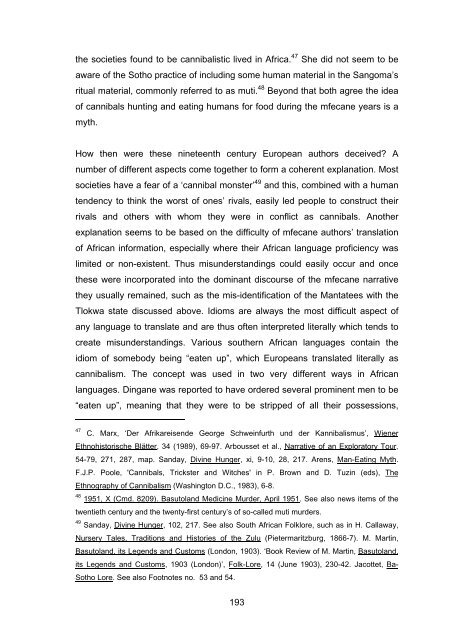The Historiographical Development of the Concept “mfecane” and ...
The Historiographical Development of the Concept “mfecane” and ...
The Historiographical Development of the Concept “mfecane” and ...
Create successful ePaper yourself
Turn your PDF publications into a flip-book with our unique Google optimized e-Paper software.
<strong>the</strong> societies found to be cannibalistic lived in Africa. 47 She did not seem to be<br />
aware <strong>of</strong> <strong>the</strong> Sotho practice <strong>of</strong> including some human material in <strong>the</strong> Sangoma’s<br />
ritual material, commonly referred to as muti. 48 Beyond that both agree <strong>the</strong> idea<br />
<strong>of</strong> cannibals hunting <strong>and</strong> eating humans for food during <strong>the</strong> mfecane years is a<br />
myth.<br />
How <strong>the</strong>n were <strong>the</strong>se nineteenth century European authors deceived? A<br />
number <strong>of</strong> different aspects come toge<strong>the</strong>r to form a coherent explanation. Most<br />
societies have a fear <strong>of</strong> a ‘cannibal monster’ 49 <strong>and</strong> this, combined with a human<br />
tendency to think <strong>the</strong> worst <strong>of</strong> ones’ rivals, easily led people to construct <strong>the</strong>ir<br />
rivals <strong>and</strong> o<strong>the</strong>rs with whom <strong>the</strong>y were in conflict as cannibals. Ano<strong>the</strong>r<br />
explanation seems to be based on <strong>the</strong> difficulty <strong>of</strong> mfecane authors’ translation<br />
<strong>of</strong> African information, especially where <strong>the</strong>ir African language pr<strong>of</strong>iciency was<br />
limited or non-existent. Thus misunderst<strong>and</strong>ings could easily occur <strong>and</strong> once<br />
<strong>the</strong>se were incorporated into <strong>the</strong> dominant discourse <strong>of</strong> <strong>the</strong> mfecane narrative<br />
<strong>the</strong>y usually remained, such as <strong>the</strong> mis-identification <strong>of</strong> <strong>the</strong> Mantatees with <strong>the</strong><br />
Tlokwa state discussed above. Idioms are always <strong>the</strong> most difficult aspect <strong>of</strong><br />
any language to translate <strong>and</strong> are thus <strong>of</strong>ten interpreted literally which tends to<br />
create misunderst<strong>and</strong>ings. Various sou<strong>the</strong>rn African languages contain <strong>the</strong><br />
idiom <strong>of</strong> somebody being “eaten up”, which Europeans translated literally as<br />
cannibalism. <strong>The</strong> concept was used in two very different ways in African<br />
languages. Dingane was reported to have ordered several prominent men to be<br />
“eaten up”, meaning that <strong>the</strong>y were to be stripped <strong>of</strong> all <strong>the</strong>ir possessions,<br />
47 C. Marx, ‘Der Afrikareisende George Schweinfurth und der Kannibalismus’, Wiener<br />
Ethnohistorische Blätter, 34 (1989), 69-97. Arbousset et al., Narrative <strong>of</strong> an Exploratory Tour,<br />
54-79, 271, 287, map. S<strong>and</strong>ay, Divine Hunger, xi, 9-10, 28, 217. Arens, Man-Eating Myth.<br />
F.J.P. Poole, 'Cannibals, Trickster <strong>and</strong> Witches' in P. Brown <strong>and</strong> D. Tuzin (eds), <strong>The</strong><br />
Ethnography <strong>of</strong> Cannibalism (Washington D.C., 1983), 6-8.<br />
48 1951, X (Cmd. 8209). Basutol<strong>and</strong> Medicine Murder, April 1951. See also news items <strong>of</strong> <strong>the</strong><br />
twentieth century <strong>and</strong> <strong>the</strong> twenty-first century’s <strong>of</strong> so-called muti murders.<br />
49 S<strong>and</strong>ay, Divine Hunger, 102, 217. See also South African Folklore, such as in H. Callaway,<br />
Nursery Tales, Traditions <strong>and</strong> Histories <strong>of</strong> <strong>the</strong> Zulu (Pietermaritzburg, 1866-7). M. Martin,<br />
Basutol<strong>and</strong>, its Legends <strong>and</strong> Customs (London, 1903). ‘Book Review <strong>of</strong> M. Martin, Basutol<strong>and</strong>,<br />
its Legends <strong>and</strong> Customs, 1903 (London)’, Folk-Lore, 14 (June 1903), 230-42. Jacottet, Ba-<br />
Sotho Lore. See also Footnotes no. 53 <strong>and</strong> 54.<br />
193

















